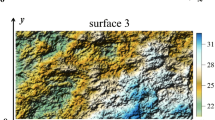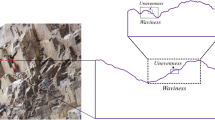Abstract
Rock joint roughness influences the mechanical and hydraulic properties of joints. To find reasons for the contradictory findings on roughness scale effects appearing in the literature, the surface roughness of a large rock joint was digitized and then quantified using six statistical parameters. The results obtained for the statistical parameters were then compared with a set of fractal parameter results obtained through the variogram method. Computed roughness parameter values showed significant roughness heterogeneity of the rock joint surface. Roughness heterogeneity has been neglected in the literature in making decisions on scale effects due to joint size. Therefore, the influence of roughness heterogeneity on the joint size effect was investigated carefully in the paper. Highly consistent results were obtained for both the statistical and fractal parameters for different joint sizes. No joint size effect was found on all the important roughness parameters when those were applied to relatively homogeneous sections of the rock joint. Negligible or slight joint size effect was found on all the important roughness parameters when those were applied to heterogeneous rock joint profiles. The possibility of having a joint size effect with increasing heterogeneity was found. Theoretically, no joint size effect exists on 100% smooth homogeneous joints. Based on this theory and the results obtained from this study, the authors strongly believe that the contradictory findings that appear in the literature on joint size effects for more than 40 years have resulted from roughness heterogeneity. This means that the rock joint heterogeneity controls the scale effect, and it can be either negative, positive, or no scale effect depending on the type and level of the heterogeneity of the rock joint surface. The studied rock joint showed significant roughness anisotropy and sampling interval effect. RMS parameter was found to be an unsuitable parameter to quantify rock joint roughness. Useful comparisons are made between several 2-D and 3-D roughness parameters. All the aforementioned are important contributions to the literature and have advanced our understanding of rock joint roughness quantification.
Article highlights
-
1.
The roughness heterogeneity plays a major role in joint size effect on roughness.
-
2.
The rock joint showed major roughness anisotropy and sampling interval effect.
-
3.
Useful comparisons are made between several 2-D and 3-D roughness parameters.


















Similar content being viewed by others
Data availability
Some or all data, models, or codes that support the findings of this study are available from the corresponding author upon reasonable request. Note that the authors do not own the raw data. Those should be requested from the researchers who own the data (a reference is given for that). However, the corresponding author can provide the data used to produce the tables and figures given in the manuscript. All the calculations were performed using MATLAB and Excel.
References
Aydan Ö, Shimizu Y, Kawamoto T (1996) The anisotropy of surface morphology characteristics of rock discontinuities. Rock Mech Rock Eng 29(1):47–59
Bandis S, Lumsden AC, Barton NR (1981) Experimental studies of scale effects on the shear behaviour of rock joints. Int J Rock Mech Min Sci Geomech Abstr 18(1):1–21
Barton N, Choubey V (1977) The shear strength of rock joints in theory and practice. Rock Mech 10(1):1–54
Barton N, Bandis S, Bakhtar K (1985) Strength, deformation and conductivity coupling of rock joints. Int J of Rock Mech Min Sci Geomech Abstr 22:121–140
Belem T, Homand-Etienne F, Souley M (2000) Quantitative parameters for rock joint surface roughness. Rock Mech Rock Eng 33(4):217–242
El-Soudani SM (1978) Profilometric analysis of fractures. Metallography 11(3):247–336
Fardin N (2008) Influence of structural non-stationarity of surface roughness on morphological characterization and mechanical deformation of rock joints. Rock Mech Rock Eng 41(2):267–297
Fardin N, Stephansson O, Jing L (2001) The scale dependence of rock joint surface roughness. Int J Rock Mech Min Sci 38(5):659–669
Fardin N, Feng Q, Stephansson O (2004) Application of a new in situ 3D laser scanner to study the scale effect on the rock joint surface roughness. Int J Rock Mech Min Sci 41(2):329–335
Ge Y, Kulatilake PHSW, Tang H, Xiong C (2014) Investigation of natural rock joint roughness. Comput Geotech 55:290–305
Ge Y, Lin Z, Tang H, Zhao B, Chen H, Xie Z, Du B (2020) Investigation of the effects of nonstationary features on rock joint roughness using the laser scanning technique. Bull Eng Geol Environ 79(6):3163–3174
Grasselli G, Wirth J, Egger P (2002) Quantitative three-dimensional description of a rough surface and parameter evolution with shearing. Int J Rock Mech Min Sci 39(6):789–800
Hsiung SM, Ghosh A, Ahola MP, Chowdhury AH (1993) Assessment of conventional methodologies for joint roughness coefficient determination. Int J Rock Mech Min Sci Geomech Abstr 30(7):825–829
Jiang Q, Feng X, Gong Y, Song L, Ran S, Cui J (2016) Reverse modelling of natural rock joints using 3D scanning and 3D printing. Comput Geotech 73:210–220
Kodikara JK, Johnston IW (1994) Shear behaviour of irregular triangular rock-concrete joints. Int J Rock Mech Min Sci Geomech Abstr 31(4):313–322
Kulatilake PHSW, Um J (1999) Requirements for accurate quantification of self-affine roughness using the roughness–length method. Int J Rock Mech Min Sci 36(1):5–18
Kulatilake PHSW, Shou G, Huang T, Morgan R (1995) New peak shear strength criteria for anisotropic rock joints. Int J Rock Mech Min Sci Geomech Abstr 32(7):673–697
Kulatilake PHSW, Um J, Pan G (1998) Requirements for accurate quantification of self-affine roughness using the variogram method. Int J Solids Struct 35(31–32):4167–4189
Kulatilake PHSW, Balasingam P, Park J, Morgan R (2006) Natural rock joint roughness quantification through fractal techniques. Geotech Geol Eng 24(5):1181–1202
Kulatilake PHSW, Du S-G, Ankah MLY, Yong R, Sunkpal DT, Zhao X, Liu G-J, Wu R (2021) Non-stationarity, heterogeneity, scale effects, and anisotropy investigations on natural rock joint roughness using the variogram method. Bull Eng Geol Environ 80:6121–6143. https://doi.org/10.1007/s10064-021-02321-3
Lanaro F (2000) A random field model for surface roughness and aperture of rock fractures. Int J Rock Mech Min Sci 37(8):1195–1210
Maerz NH, Franklin JA, Bennett CP (1990) Joint roughness measurement using shadow profilometry. Int J Rock Mech Min Sci Geomech Abstr 27(5):329–343
Mandelbrot B (1967) How long is the Coast of Britain? Statistical self-similarity and fractional dimension. Science 156(3775):636–638
Miller SM, McWilliams PC, Kerkering JC (1990) Ambiguities in estimating fractal dimensions of rock fracture surfaces. Paper presented at the 31st US Symposium on Rock Mechanics (USRMS)
Myers N (1962) Characterization of surface roughness. Wear 5(3):182–189
Roko RO, Daemen JJK, Myers DE (1997) Variogram characterization of joint surface morphology and asperity deformation during shearing. Int J Rock Mech Min Sci 34(1):71–84
Sayles RS, Thomas TR (1977) The spatial representation of surface roughness by means of the structure function: a practical alternative to correlation. Wear 42(2):263–276
Shirono T, Kulatilake PHSW (1997) Accuracy of the spectral method in estimating fractal/spectral parameters for self-affine roughness profiles. Int J Rock Mech Min Sci 34(5):789–804
Tatone BS, Grasselli G (2009) A method to evaluate the three-dimensional roughness of fracture surfaces in brittle geomaterials. Rev Sci Instrum 80(12):125110
Tatone BSA, Grasselli G (2010) A new 2D discontinuity roughness parameter and its correlation with JRC. Int J Rock Mech Min Sci 47(8):1391–1400
Tatone BSA, Grasselli G (2013) An investigation of discontinuity roughness scale dependency using high-resolution surface measurements. Rock Mech Rock Eng 46(4):657–681
Tse R, Cruden DM (1979) Estimating joint roughness coefficients. Int J Rock Mech Min Sci Geomech Abstr 16(5):303–307
Wu TH, Ali EM (1978) Statistical representation of joint roughness. Int J Rock Mech Min Sci Geomech Abstr 15(5):259–262
Xie H, Wang J-A, Xie W-H (1997) Fractal effects of surface roughness on the mechanical behavior of rock joints. Chaos Soliton Fract 8(2):221–252
Yong R, Ye J, Liang Q-F, Huang M, Du S-G (2018) Estimation of the joint roughness coefficient (JRC) of rock joints by vector similarity measures. Bull Eng Geol Environ 77(2):735–749
Yu X, Vayssade B (1991) Joint profiles and their roughness parameters. Int J Rock Mech Min Sci Geomech Abstr 28(4):333–336
Acknowledgements
The authors would like to thank Prof. Shi-Gui Du and Dr. Rui Yong for allowing to use the roughness data used in this paper. The financial support the last author received from the Distinguished Foreign Expert Talent Program Funding is gratefully acknowledged.
Author information
Authors and Affiliations
Contributions
Prof. PHSWK has contributed to the paper on the following aspects: development and implementation of ideas, analysis and interpretations, manuscript drafting and critically revisiting, responding to the reviewer comments, intellectual responsibility for its content, and supervision of the graduate student work on the paper. The graduate students, MLYA, DTS, and XZ, have contributed to the paper on the following aspects: development and implementation of ideas, data preparation for analysis, analysis and interpretations, manuscript drafting, and manuscript preparation according to the journal formats.
Corresponding author
Ethics declarations
Conflict of interest
The authors declare that they have no conflict of interest.
Additional information
Publisher's Note
Springer Nature remains neutral with regard to jurisdictional claims in published maps and institutional affiliations.
Rights and permissions
About this article
Cite this article
Ankah, M.L.Y., Sunkpal, D.T., Zhao, X. et al. Role of heterogeneity on joint size effect, and influence of anisotropy and sampling interval on rock joint roughness quantification. Geomech. Geophys. Geo-energ. Geo-resour. 8, 101 (2022). https://doi.org/10.1007/s40948-022-00413-2
Received:
Accepted:
Published:
DOI: https://doi.org/10.1007/s40948-022-00413-2




